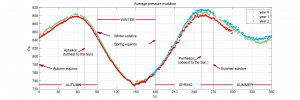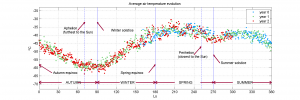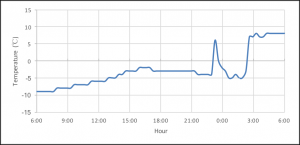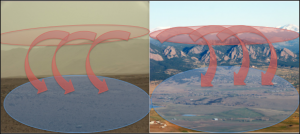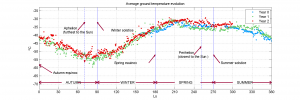Jorge Pla-García, Antonio Molina, Javier Gómez-Elvira and REMS team
The tenth month of the thirty-third Mars year [1] goes from sol [2] 1534 to 1581 since the Curiosity landing. The rover drove uphill along 200 meters and climbed 15 meters in elevation on Aeolis Mons [3] –an average slope of 7.5%– during these 47 sols. The area is located on the Bagnold dunes that overlie the Murray formation, composed of a fluvial-lacustrine mixture of materials, mostly fractured mudstones, with dark sand banks covering them in patches. According to the Sun position, this month goes from 270 to 300 solar longitude [4] (Ls), being the first summer month –of three– in the southern hemisphere.
Atmospheric pressure
As can be noted in Fig. 1, the annual maximum of atmospheric pressure [5] was measured during the previous month, matching with the highest CO2 sublimation (ice turning into gas) in the martian south pole. The atmospheric pressure begins to drop during this month. As the autumn equinox approaches, the CO2 in the atmosphere starts to freeze over the southern polar cap, decreasing the air pressure. As expected, the atmospheric pressure is lower this month compared to the same month of previous years, since the rover is climbing Aeolis Mons –the higher the elevation, the lower the air pressure.
Figure 1. Average pressure evolution measured by REMS instrument inside Gale crater (Source: CAB) Click image to enlarge.
The highest daily air pressure is registered during the sunrise and the lowest during the sunset. Mars thermal tides [6] are the weather phenomenon responsible for these significant, daily variations. Together with thermal tides effect, the local air circulation causes air to flow away from the crater interior during the day and flow back during the night, as a consequence of the descending air along slopes.
The typical air pressure oscillation registered at ~08:00 pm during the previous seasons was not recorded this month. The local crater air circulation at that time is balanced with global and regional air currents.
Air temperature
Temperatures were below zero during all the month, something common on Mars. The average temperature was around -40 °C, with an average daily maximum of almost -12 °C, while the minimum was around -70 °C (Fig. 2). It is important to note, however, that the temperatures oscillate every day about 60 °C, that is, more in a single sol than the annual average.
Figure 2. Average air temperature evolution measured by REMS instrument inside Gale crater (Source: CAB) Click image to enlarge.
During this month, temperatures were stable. Gone is the spring, where solar radiation was maximum at Gale crater, and so the temperatures, which reached an absolute maximum value of +4 °C on hottest sol of the martian year. Also, in Figure 2, one can tell that the temperature evolution this year is very similar to the previous ones.
Atmospheric Circulation
On Mars, there is a dramatic difference between the lowlands of the northern hemisphere and the highlands of the south. This circumstance develops nocturnal winds from the south (at night, cold winds sink from the south due to being heavier) during most of the year. However, during this month, the winds from the northwest are especially intense at night, defeating the southern winds for the first time in the year.
On the other hand, during the evening, an inversion [7] develops at the crater rim and outside the crater, setting up the ideal conditions for a mountain wave [8], which descends to the surface during evening/night. Mountain waves are not thermally driven buoyancy circulations, unlike slope circulations. Instead, some mesoscale flows, like mountain waves, are dynamically generated by the interaction of the wind with the topography. These dynamic phenomena can oppose buoyancy forces and provide a mechanism for warm air to descend or for cold air to rise. Therefore, this is the ideal scenario for flush the crater out completely. This phenomenon occurs from mid-spring, peaking in summer solstice (Ls 270) and ending in mid-summer (Ls 225 – Ls 315).
These scenarios are fairly common near mountainous terrain on Earth and are responsible for downslope windstorms, like Foehn winds in the lee of the Alps and Chinook winds in the lee of the Rocky Mountains. The latter shows us an outstanding example in the midnight of February 3rd-4th. With cold dense air at the surface across most of Northeast Colorado and relatively warm air aloft over the Central Rockies, strong west winds aloft worked overnight to push the cold air out. A temperature battle happened around Boulder (CO) area with approximately ~12 °C of temperature change in about 4 hours. Temperatures went from -5 °C at 10:30 pm up to +7 °C by midnight. The temperature went back down to -6 °C as the westerly winds weakened temporarily before strengthening again allowing temps to rise back above +8 °C during all night long. This magnitude of temperature change along a cold/warm air boundary is fairly common in the winter months across the high plains, east of the Rocky Mountains. This process is fairly common in this area during the winter months, as it is in Gale crater on Mars during the summer, a unique time of the year when mountain waves develop (Fig. 4).
Figure 3. The temperature battle along Rocky Mountains base. When approaching February 4th midnight near Boulder (CO), temperatures oscillated around 12 °C due to warm downslope winds forced by mountain waves (Data source: The Weather Company) Click image to enlarge.
Figure 4. Strong winds develops mountain waves that sink warm air masses from the top of the Rockies to the cold plains triggering a temperature battle ensued overnight both near Boulder (right side, source NCAR edited) and at Gale crater (left side, source NASA edited) Click image to enlarge.
Ground temperature
The average ground temperature measured this month was very stable around -33 °C (Fig. 5), which is a bit higher than during the same month of previous years. These small daily variations could be caused by a low and constant thermal inertia of the materials that the rover found along her track. The multiple dune fields close to the rover is consistent with this behavior, since the small particle size of the sand reduces its capability to store heat, and follow fast the thermal variations on the air. Those temperatures change dramatically during the day, with a 80 to 100degree difference between day and night – much higher that the seasonal variations.
Figure 5. Evolution of the ground temperatures measured by REMS instrument inside Gale crater (Source: CAB) Click image to enlarge.
Glossary
[1] In an arbitrary convention, April 11th 1955 was adopted as the beginning of Mars year 1, because it was the year before the global dust storm of 1956, the first one to be investigated in detail. Also, 1956 was an International Geophysics Year and that it had the best Mars “opposition” for the previous 15 years. A year on Mars lasts twice as long (687 Earth days) because Mars is farther away from the sun and has to travel a greater distance around it.
[2] Sol is a martian day, that lasts 24 hours and 40 minutes (in terrestrial time). The sol number is the number of sols since the Curiosity rover landed in Gale crater.
[3] Aeolis Mons is the central mound inside Gale crater, also known informally as Mount Sharp in memory of the American planetary geologist Robert P. Sharp.
[4] Solar longitude is commonly referred to as Ls, this is the angular position of Mars relative to the Sun measured in degrees from the summer equinox (start of northern hemisphere Spring). The Ls year is divided into 360 fractions (degrees).
[5] The main component of the martian atmosphere is CO2, so the atmospheric pressure is mostly influenced by the total mass of this gas above the surface. The CO2 is seasonally stored in the poles as an ice cap overlying another ice cap made of water (and dust).
[6] Thermal tides occurs when sunlight heats the surface and atmosphere on the day side of the planet, causing air to expand upwards. At higher levels in the atmosphere, this bulge of air then expands outward, to the sides, in order to equalize the pressure around it. Air flows out of the bulge, lowering the pressure of air felt at the surface below the bulge. The result is a deeper atmosphere, but one that is less dense and has a lower pressure at the surface, than that away from the subsolar point. As Mars rotates beneath the sun, this bulge moves across the planet each day, from east to west. A fixed observer, such as REMS, measures a decrease in pressure during the day, followed by an increase in pressure at night.
[7] Inversion occurs when the temperature of the air near the surface is colder than at height, producing atmospheric stability (convection is small).
[8] A mountain wave is an atmospheric phenomenon in which, as a consequence of air flowing over a marked topographic feature (mountain, crater, etc.), it adopts a wavy behavior leeward of the obstacle, forcing dynamic rises and descents of air masses. There are four conditions that must be fulfilled to form the wave: the direction of the wind must be perpendicular to the topographic feature; the wind intensity must be strong and increasing with high; an inversion must be present so that the prevailing atmospheric stability guarantees the confinement of the wave at lower levels.
Thanks to REMS team for their effort and the valuable data.
